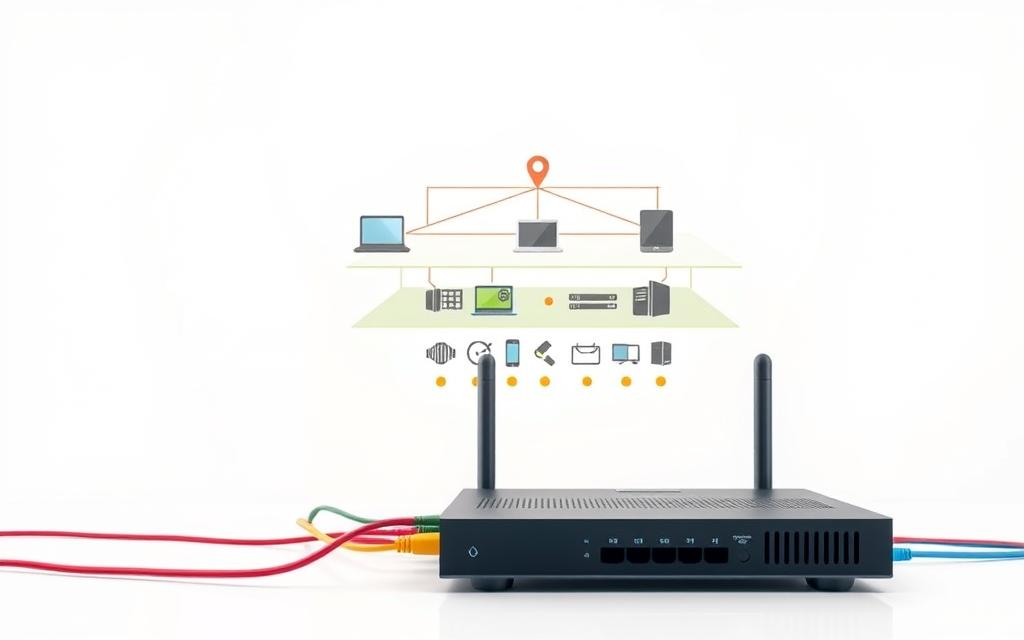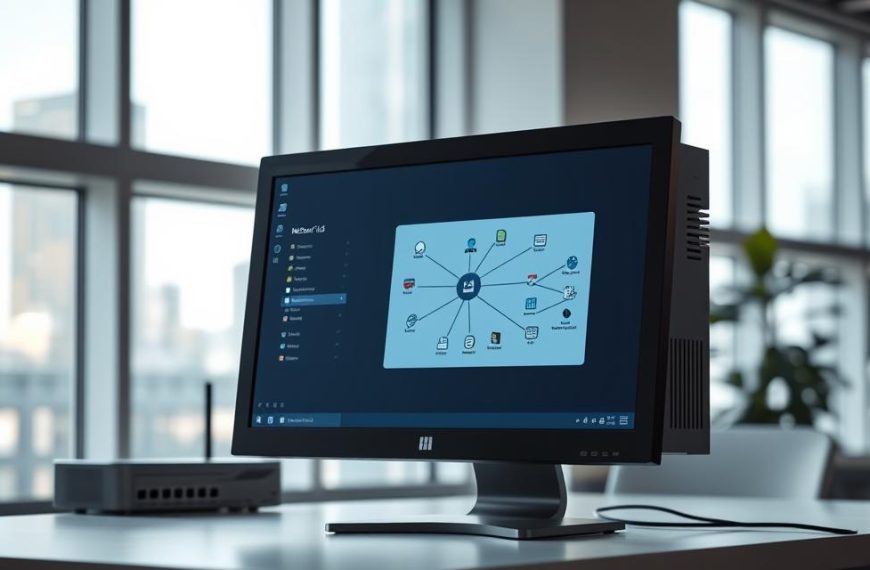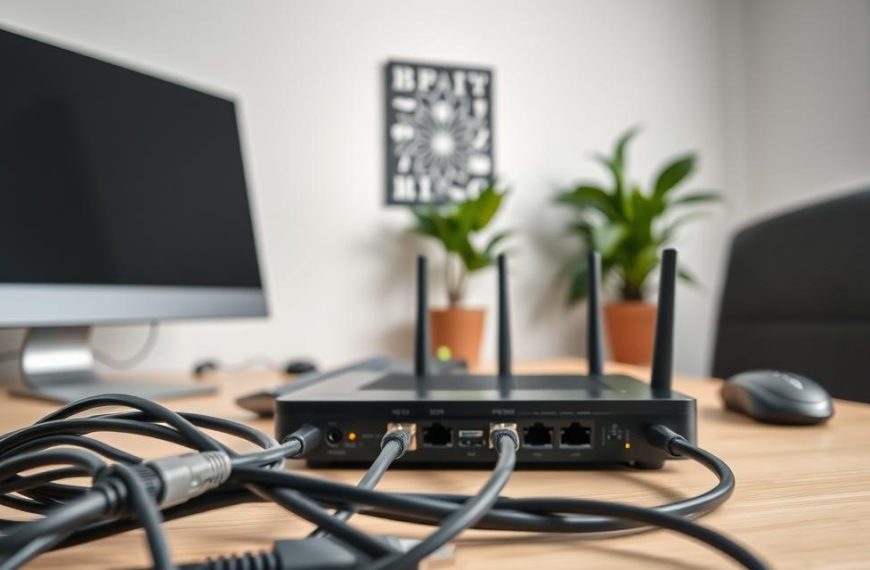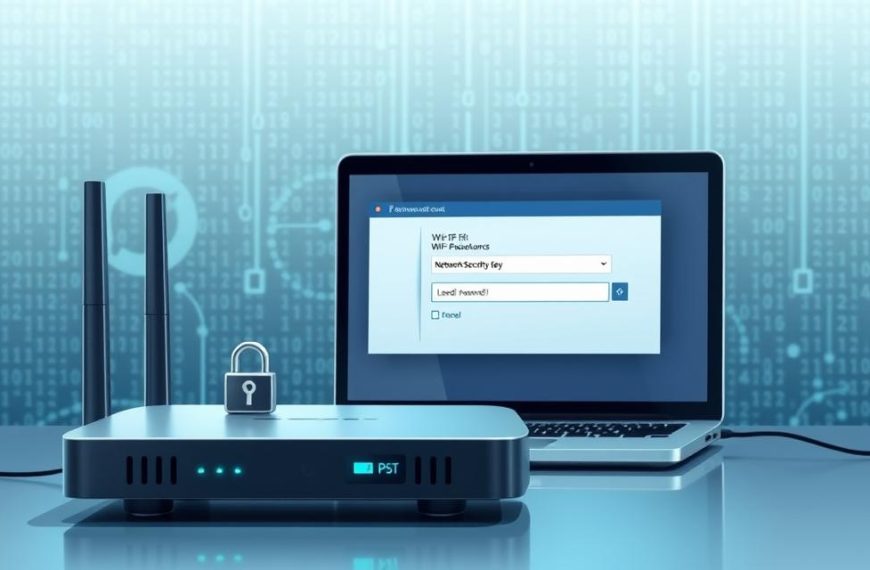Imagine trying to build a complex structure without blueprints or communicate without a shared language. This shows the chaos in digital communications without frameworks. Network models give the architecture needed for systems to understand each other.
These frameworks organise communication into computer network layers, each with its own role. The layered approach makes complex interactions simpler. It ensures data is transmitted smoothly across different systems.
The OSI model is well-known, with seven layers for communication. It acts as a universal language for networking, bridging different technologies. On the other hand, the internet mainly uses the simpler TCP/IP model.
Knowing these architectures is key for those working with data communication protocols. They are essential for making systems work together, solving problems, and creating new network technologies. This knowledge is vital for reliable digital communication systems around the world.
Understanding Network Models and Their Significance
Network models are key to how different computers talk to each other. They break down networking into layers, making data sharing easier across systems.
The Purpose of Structured Network Architectures
Structured network architectures are vital in today’s computing world. They simplify complex communication by breaking it down into smaller parts. This makes designing and setting up systems easier.
The layered approach has many benefits:
- Modular design lets developers work on one layer without affecting others
- Easier troubleshooting because you can test specific layers separately
- Faster innovation as you can update one layer at a time
- Interoperability between different systems
This organised way ensures that parts from different makers work well together. The OSI model’s standardisation has been key to networking’s rapid growth.
Historical Development of Network Models
The history of network models shows how computer communication has grown. Before standards, different systems made things hard to connect.
The OSI model changed this. It was the first big standard for network communication, adopted by major companies in the early 1980s.
Important moments in networking history include:
- The OSI model was introduced in 1983
- It became an ISO standard in 1984
- It was widely used in the telecom industry
- It laid the groundwork for future networking standards
This standardisation was a big step forward. It helped developers and makers work together, creating our connected world today.
The ISO standard’s layered model has shaped network design. It’s lasted through many changes in technology and protocols.
What Is a Network Model in Computer Network
Network models are like blueprints for how devices talk to each other online. They help organize communication into clear groups. This makes it easier to design and run complex networks.
Defining the Network Model Concept
A network model is a structured way to design and use communication systems. It acts as a guide that makes sure data moves smoothly from one place to another. It breaks down big networking tasks into smaller, easier-to-handle layers.
Each layer does a specific job and helps the next one. This makes it easier for developers and engineers to work on certain parts of the network. They don’t have to know everything at once.
Key Components and Benefits of Layered Architectures
Layered architectures have important parts that work together. Protocols set rules for how devices talk at each layer. Interfaces show how layers connect, and services explain what each layer does.
The benefits of OSI model and similar systems are big. They make it possible for different brands to work together. This saves money and makes it easier for network managers to change things.
Fixing problems is easier with layered systems. Technicians can find and fix issues in one layer without looking at the whole system. It also helps with learning and training by making networking concepts clear.
Security gets better because each layer can have its own protection. This makes networks safer. It also makes it easier to add new things without messing up what’s already there.
| Component | Function | Practical Benefit |
|---|---|---|
| Protocols | Define communication rules | Ensures standardised data exchange |
| Interfaces | Connect adjacent layers | Enables modular design and upgrades |
| Services | Provide specific functionality | Simplifies development and maintenance |
| Layered Structure | Separates concerns | Improves troubleshooting efficiency |
When companies define network model needs well, they plan better. This helps them know what hardware and software they need before they start. This makes it easier for vendors to make products that fit well together.
The layered network benefits also help with keeping up with new technology. New protocols can be added without having to change everything. This makes layered models great for keeping up with fast changes in technology.
The OSI Reference Model: Seven Layers Explained
The OSI reference model breaks down network communications into seven layers. This structure helps different network technologies work together smoothly. It also makes sure each layer has its own job.
Physical Layer: The Foundation of Connectivity
The physical layer is the most basic part of network communication. It deals with the hardware and how bits are sent over physical media. This includes cables, connectors, network interface cards, and wireless signals.
Its main tasks are setting electrical standards, data rates, and transmission modes. The physical layer makes sure bits are sent from one device to another. It uses media like copper wire, fibre optics, and radio waves. Without it, digital communication wouldn’t be possible.
Data Link Layer: Ensuring Reliable Node-to-Node Delivery
The data link layer is above the physical layer. It makes sure data is delivered reliably between connected nodes. It organises bits into frames and adds control information. It uses MAC addresses to identify devices.
This layer also checks for errors and controls data flow. It prevents fast senders from overwhelming slower receivers. Ethernet is a common technology at this layer, supporting local area networks.
Network Layer: Managing Data Routing and Addressing
The network layer introduces logical addressing and routing. It uses IP addresses to identify devices across networks and finds the best path for data. Routers mainly work at this layer, making smart forwarding decisions.
Its main tasks are forwarding packets, calculating routes, and handling congestion. This layer is key for communication between devices not directly connected. IP (Internet Protocol) is the main protocol here.
Transport Layer: End-to-End Communication Management
The transport layer ensures data is delivered completely and reliably. It breaks down large messages into smaller units and puts them back together at the end. It also manages quality-of-service, like error recovery and flow control.
Two main protocols work here: TCP and UDP. TCP offers reliable, connection-oriented communication. UDP is for fast, connectionless transmission, good for real-time applications.
Essential Network Protocols and Their Functions
Network models give us the blueprint, but protocols are the rules for devices to talk to each other. They tell us how to format, send, and get data across networks.
Knowing these protocols is key for network managers and IT pros. They help make networks run better and stay safe. Each protocol does its part to make data sharing smooth.
TCP/IP Protocol Suite: The Internet’s Backbone
The TCP/IP protocol suite is the internet’s main language. It’s not just a theory like OSI, but a real solution that combines layers into four main parts.
This stack includes:
- Network Interface Layer (combining Physical and Data Link)
- Internet Layer (handling routing and addressing)
- Transport Layer (managing end-to-end connections)
- Application Layer (providing user services)
The TCP/IP protocol is simple and works well. It’s why it’s the top choice for networks today. It ensures data gets through safely, no matter the network.
Application Layer Protocols: HTTP, FTP, and SMTP
Application layer protocols offer services that users use every day. They sit at the top of OSI and TCP/IP models.
HTTP is key for the web. It helps send web pages and resources between servers and clients. Now, HTTPS is used for extra security.
FTP is great for moving files around. It’s used for uploading and downloading, helping with website updates and big file sharing.
SMTP deals with email. It helps send and receive emails across networks. It works with other email protocols to offer full email services.
| Protocol | Primary Function | Default Port | Security Considerations |
|---|---|---|---|
| HTTP | Web page transmission | 80 | Upgrade to HTTPS recommended |
| FTP | File transfers | 21 | Use SFTP or FTPS for security |
| SMTP | Email routing | 25 | Implement TLS encryption |
Security Protocols: SSL/TLS and IPsec
Modern networks need strong security protocols to keep data safe. These protocols protect data from being seen, changed, or faked.
SSL and TLS create secure connections between devices. They work between the Transport and Application layers, keeping web browsing and email safe.
IPsec works at the Network Layer, giving strong protection for IP traffic. It encrypts data, checks who sent it, and stops attacks.
These security protocols are key for VPNs and secure remote access. They’re essential for keeping data safe when it’s moving.
For more on networking protocols, check out this guide on common network protocols. It explains their roles in today’s networks.
Practical Applications and Modern Implementations
Network models become powerful tools when used in real life. They help network experts design, fix, and improve digital systems. This is key for modern networks.
Real-World Network Model Implementations
Think about sending an email from London to Tokyo. This shows how OSI model applications work across the globe. Your email starts at the application layer, then moves through other layers for formatting and connection.
The transport layer breaks your message into packets. The network layer adds addresses for international routes. Data link and physical layers handle the actual sending over cables, fibre, or wireless.
Today, networks mostly use the TCP/IP model, not pure OSI. But OSI is great for:
- Network troubleshooting and diagnostics
- Educational purposes and understanding
- Protocol development and standardisation
- Cross-platform compatibility planning
Choosing the Right Model for Different Network Scenarios
Choosing the right network architecture is important. It depends on your specific needs. Different scenarios need different approaches to implementing network models well.
For internet apps, the TCP/IP model fits well. Its four-layer structure matches internet protocols. Corporate networks often use OSI for complex, multi-vendor setups.
When choosing network architecture, consider these factors:
| Network Scenario | Recommended Model | Key Considerations |
|---|---|---|
| Internet Services & Web Applications | TCP/IP Model | Native protocol support, internet compatibility |
| Corporate Network Design | OSI Reference Model | Troubleshooting ease, vendor interoperability |
| Educational Context | OSI Reference Model | Conceptual clarity, complete understanding |
| Specialised Industrial Networks | Hybrid Approach | Specific protocol needs, reliability |
The table shows how context affects model choice. Many use both OSI for troubleshooting and TCP/IP for implementation.
No single approach fits all. The best network architects know both models well. They use them wisely based on technical needs and goals.
Conclusion
This look into network architectures gives a full view of the models that underpin digital communication. The OSI and TCP/IP frameworks show how vital network layers are. They help sort out complex data transmission.
Knowing about these layers helps IT experts a lot. They can fix problems, improve security, and make networks better. The clear roles of each layer make solving issues and designing systems easier.
These models are key in both learning and using technology. For a deeper dive, check out this in-depth look at OSI and TCP/IP. It highlights their strengths and how they work in the real world.











